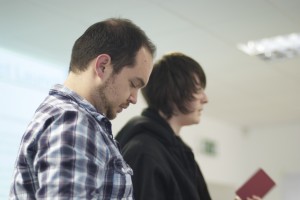This group shared that they viewed social isolation as someone who is lonely in their house, but identified many factors that contribute to isolation, and many different situations, that they are now of the opinion that every case of social isolation is incredibly individual. However, this group also set out their stall by saying that it can be difficult to identify social isolation before it happens and people may not believe that they are isolated.
What this group learned:
– Money and legalities are always a factor.
– Some services can approach social isolation quite bureaucratically and more flexibility may be needed in service provision.
– Workers are given tasks when they are working in people’s homes, which tends not to involve engaging socially with people, generally due to time constraints.
– How different sectors engage with people and other services.
– Identified lots of different problems (see slides) and realised that lots of people’s first port of call is a GP.
– There does not seem to be a consistent way of keeping people active and engaged in their community to prevent social isolation in the first place.
– The group saw one way BUPA address social isolation by bringing older people and children together in a garden.
So what does social isolation mean and feel like?
Working with older people and carers, this group also built profiles of people and what social isolation means to them. They mapped who they were connecting with, how they did this, and what the purpose of these connections were (see slides). The group identified archetypes of people who become socially isolated: these were self managed, physical isolation, mental, fear based, care induced and knowledge (for more information see slides).
It was also interesting to see that when carers and older people were asked to choose which thematic group to talk to in the afternoon, the carers mainly wanted to talk about this issue.
Insights from this group included:
– There isn’t a way to identify people who are at risk of social isolation.
– One of the causes of isolation is a lack of confidence.
– There is a lack of knowledge about services available to people.
Feedback from the audience included:
This is an incredibly hard issue to address in terms of identifying who is socially isolated.
The group need to look at how the voluntary sector is involved in social isolation.
Develop the process to support someone who is socially isolated ready, rather than focus on the person. There are bits missing in the current system to have this process ready.
Something that already exists is the HUB which gives advice about services that support people not to become socially isolated.
Police and housing are obliged to report instances of social isolation.
You need to consider whether a person has capacity to be able to be provided services that deal with social isolation.’Capacity’ can be difficult to identify.
It can be difficult for all GPs to know what is available in their community, but if they are able to pass on information, the person still needs the confidence to phone or attend a service.
Remember older people are the same as all of us – they want friends not services.
Some people choose to be isolated and personal choices also need to be respected.

